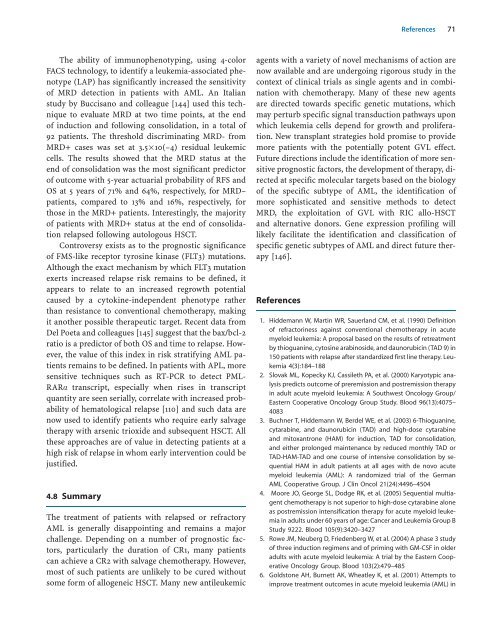Acute Leukemias - Republican Scientific Medical Library
Acute Leukemias - Republican Scientific Medical Library
Acute Leukemias - Republican Scientific Medical Library
Create successful ePaper yourself
Turn your PDF publications into a flip-book with our unique Google optimized e-Paper software.
a References 71<br />
The ability of immunophenotyping, using 4-color<br />
FACS technology, to identify a leukemia-associated phenotype<br />
(LAP) has significantly increased the sensitivity<br />
of MRD detection in patients with AML. An Italian<br />
study by Buccisano and colleague [144] used this technique<br />
to evaluate MRD at two time points, at the end<br />
of induction and following consolidation, in a total of<br />
92 patients. The threshold discriminating MRD- from<br />
MRD+ cases was set at 3.5´ 10(–4) residual leukemic<br />
cells. The results showed that the MRD status at the<br />
end of consolidation was the most significant predictor<br />
of outcome with 5-year actuarial probability of RFS and<br />
OS at 5 years of 71% and 64%, respectively, for MRD–<br />
patients, compared to 13% and 16%, respectively, for<br />
those in the MRD+ patients. Interestingly, the majority<br />
of patients with MRD+ status at the end of consolidation<br />
relapsed following autologous HSCT.<br />
Controversy exists as to the prognostic significance<br />
of FMS-like receptor tyrosine kinase (FLT3) mutations.<br />
Although the exact mechanism by which FLT3 mutation<br />
exerts increased relapse risk remains to be defined, it<br />
appears to relate to an increased regrowth potential<br />
caused by a cytokine-independent phenotype rather<br />
than resistance to conventional chemotherapy, making<br />
it another possible therapeutic target. Recent data from<br />
Del Poeta and colleagues [145] suggest that the bax/bcl-2<br />
ratio is a predictor of both OS and time to relapse. However,<br />
the value of this index in risk stratifying AML patients<br />
remains to be defined. In patients with APL, more<br />
sensitive techniques such as RT-PCR to detect PML-<br />
RARa transcript, especially when rises in transcript<br />
quantity are seen serially, correlate with increased probability<br />
of hematological relapse [110] and such data are<br />
now used to identify patients who require early salvage<br />
therapy with arsenic trioxide and subsequent HSCT. All<br />
these approaches are of value in detecting patients at a<br />
high risk of relapse in whom early intervention could be<br />
justified.<br />
4.8 Summary<br />
The treatment of patients with relapsed or refractory<br />
AML is generally disappointing and remains a major<br />
challenge. Depending on a number of prognostic factors,<br />
particularly the duration of CR1, many patients<br />
can achieve a CR2 with salvage chemotherapy. However,<br />
most of such patients are unlikely to be cured without<br />
some form of allogeneic HSCT. Many new antileukemic<br />
agents with a variety of novel mechanisms of action are<br />
now available and are undergoing rigorous study in the<br />
context of clinical trials as single agents and in combination<br />
with chemotherapy. Many of these new agents<br />
are directed towards specific genetic mutations, which<br />
may perturb specific signal transduction pathways upon<br />
which leukemia cells depend for growth and proliferation.<br />
New transplant strategies hold promise to provide<br />
more patients with the potentially potent GVL effect.<br />
Future directions include the identification of more sensitive<br />
prognostic factors, the development of therapy, directed<br />
at specific molecular targets based on the biology<br />
of the specific subtype of AML, the identification of<br />
more sophisticated and sensitive methods to detect<br />
MRD, the exploitation of GVL with RIC allo-HSCT<br />
and alternative donors. Gene expression profiling will<br />
likely facilitate the identification and classification of<br />
specific genetic subtypes of AML and direct future therapy<br />
[146].<br />
References<br />
1. Hiddemann W, Martin WR, Sauerland CM, et al. (1990) Definition<br />
of refractoriness against conventional chemotherapy in acute<br />
myeloid leukemia: A proposal based on the results of retreatment<br />
by thioguanine, cytosine arabinoside, and daunorubicin (TAD 9) in<br />
150 patients with relapse after standardized first line therapy. Leukemia<br />
4(3):184–188<br />
2. Slovak ML, Kopecky KJ, Cassileth PA, et al. (2000) Karyotypic analysis<br />
predicts outcome of preremission and postremission therapy<br />
in adult acute myeloid leukemia: A Southwest Oncology Group/<br />
Eastern Cooperative Oncology Group Study. Blood 96(13):4075–<br />
4083<br />
3. Buchner T, Hiddemann W, Berdel WE, et al. (2003) 6-Thioguanine,<br />
cytarabine, and daunorubicin (TAD) and high-dose cytarabine<br />
and mitoxantrone (HAM) for induction, TAD for consolidation,<br />
and either prolonged maintenance by reduced monthly TAD or<br />
TAD-HAM-TAD and one course of intensive consolidation by sequential<br />
HAM in adult patients at all ages with de novo acute<br />
myeloid leukemia (AML): A randomized trial of the German<br />
AML Cooperative Group. J Clin Oncol 21(24):4496–4504<br />
4. Moore JO, George SL, Dodge RK, et al. (2005) Sequential multiagent<br />
chemotherapy is not superior to high-dose cytarabine alone<br />
as postremission intensification therapy for acute myeloid leukemia<br />
in adults under 60 years of age: Cancer and Leukemia Group B<br />
Study 9222. Blood 105(9):3420–3427<br />
5. Rowe JM, Neuberg D, Friedenberg W, et al. (2004) A phase 3 study<br />
of three induction regimens and of priming with GM-CSF in older<br />
adults with acute myeloid leukemia: A trial by the Eastern Cooperative<br />
Oncology Group. Blood 103(2):479–485<br />
6. Goldstone AH, Burnett AK, Wheatley K, et al. (2001) Attempts to<br />
improve treatment outcomes in acute myeloid leukemia (AML) in
















